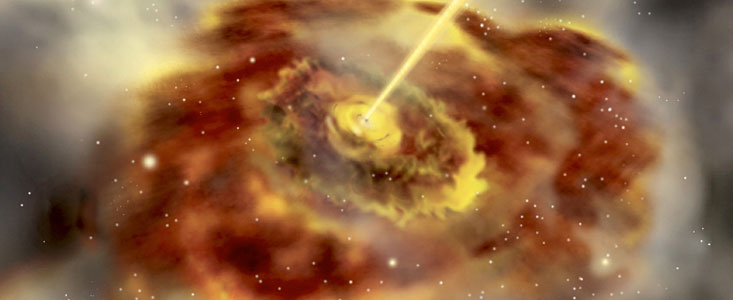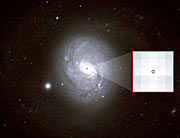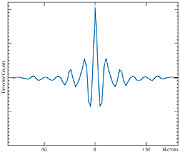Komunikat prasowy
A First Look at the Doughnut Around a Giant Black Hole
First detection by infrared interferometry of an extragalactic object
19 czerwca 2003
Active galactic nuclei (AGN) are one of the most energetic and mysterious phenomena in the universe. In some galaxies indeed, the core generates amounts of energy which surpass those of normal galaxies, such as the Milky Way, by many orders of magnitude. The central engine of these power stations is thought to be a supermassive black hole. Indirect lines of evidence have suggested that these massive black holes are enshrouded in a thick doughnut-shaped structure of gas and dust, which astronomers call a "torus". However, due to the limited sharpness of images that can be obtained with present telescopes in the 10-m range, such a torus has never been imaged to date. Using the new and powerful VLT Interferometer [1] - a mode of the ESO Very Large Telescope that combines light from at least two telescopes to obtain information on very fine scales - a team of European astronomers [2] has succeeded for the first time in resolving structures in the dusty torus of the prototype AGN, the famous galaxy NGC 1068. The structures have a size of roughly 0.03 arcsec, corresponding to about 10 light-years at the distance of the galaxy. This important achievement shows that the VLT Interferometer, using the recently inaugurated MIDI instrument [3], proves an invaluable tool in the study of objects outside our own Galaxy.
Cosmic power station
Active galaxies are among the most spectacular objects in the sky. Their compact nuclei (AGN) are so luminous that they can outshine an entire galaxy. These objects show many interesting observational characteristics over the whole electromagnetic spectrum, ranging from radio to X-ray emission.
Active galaxies take many forms: some have bright nuclei emitting high-energy (i.e. ultraviolet and X-rays) photons, some have high-energy nuclei but appear to be surrounded by a more-or-less "normal" galaxy, while some have long narrow jets or beams of matter streaming out from the centre.
There is now much evidence that the ultimate power station of these activities originate in supermassive black holes with masses up to thousands of millions times the mass of our Sun. The black hole is fed from a tightly wound accretion disc encircling it. Material that falls towards such black holes will be compressed and heated up to tremendous temperatures. This hot gas radiates an enormous amount of light, causing the active galaxy nucleus to shine so brightly.
Enshrouded in the mystery torus
The central region of an active nucleus is currently believed to be surrounded by a doughnut of dense and opaque gas and dust. It was first thought that the different types of active galaxies were fundamentally different objects. Astronomers now prefer the so-called "unified" model of AGN, meaning that most or all AGN are actually just different versions of the same object. What the object looks like depends on the orientation of the doughnut on our line of sight : can we see through the doughnut hole deep into the bright centre or can we only see the opaque walls ? Some AGN appear indeed very luminous because we see straight down to the emission site, while others would be very dim, since the torus hides the central power station from our view. These doughnuts or tori are, however, very difficult to resolve because of their very small size, typically a few tens of light-years. For the nearest active galaxy, this corresponds to an estimated angular diameter less than 0.05 arcsec, much smaller than what can be observed with present single large telescopes in the 10-m range.
Since, so far, evidence for the tori is only indirect, a large variety of models has been proposed as to how these tori could be, varying from very dense and compact tori, to very extended and fluffy tori. What the astronomers really need, in order to differentiate among the models, is a direct image of a torus. But until now, no telescope could see sharp enough to spot one.
This is where interferometry with large telescopes makes a difference. Interferometry is the technique which combines two or more telescopes to achieve an angular resolution equal to that of a telescope as large as the separation of the individual ones. The recently inaugurated ESO Very Large Telescope Interferometer on top of the Paranal mountain has the ambitious goal of making interferometry a tool available to every astronomer. Just a few months ago, the first of the powerful instruments for the VLTI was installed, the 10 micron beam combiner mid-infrared interferometric instrument. This will be followed in early 2004 by the AMBER instrument [4].
MIDI is sensitive to light of a wavelength near 10 microns, i.e. in the mid-infrared spectral region (the so-called "thermal infrared"). Located at the heart of the VLT Interferometer with its multiple baselines of up to 200 m, MIDI can reach an angular resolution of about 0.01 arcsec. Combined with two powerful 8.2-m VLT Unit Telescopes, MIDI has for the first time in infrared interferometry enough sensitivity to study objects far away from our galaxy, the Milky Way.
With its high sensitivity to thermal radiation, MIDI is ideally suited to study cosmic material near a central object and heated by its radiation. The ultraviolet and optical radiation from the hot material surrounding the black hole indeed heats the dust torus to several hundred degrees. The absorbed energy is then re-radiated in the thermal infrared between 5 and 100 microns.
The MIDI instrument on the VLTI is thus the most appropriate instrument to peer at the enigmatic dust and gas tori believed to be located around giant black holes at the centres of quasars and Active Galactic Nuclei.
And since nobody has ever been able to use interferometry to study faint objects in the thermal infrared, MIDI enters into a whole unexplored territory.
On the nights of June 14 to 16, a team of European astronomers [2] conducted a first series of observations to verify the scientific potential of MIDI on the VLTI. Among them, they studied the active galaxy NGC 1068.
NGC 1068: a prototype AGN
NGC 1068 is among the brightest and most nearby active galaxies. Located in the constellation Cetus at a distance of about 60 million light years, it is also known as Messier 77. It is in fact one of the biggest galaxies in Messier's catalogue and one of the first recognised spiral galaxies. On optical images, NGC 1068 looks indeed like a rather normal barred spiral galaxy. The core of the galaxy, however, is very luminous not only in the optical, but also in ultraviolet and X-ray light. A black hole with a mass equivalent to approximately 100 million stars like our Sun is required to account for the nuclear activity in NGC 1068.
Fringes in the distant dust: resolving the torus in NGC 1068
The MIDI observations used two of the 8.2 m VLT Unit Telescopes (Antu and Melipal), separated by a baseline of 102 m. Due to projection effects, the actual baseline for the NGC 1068 observations amounted to 79 m. While observing NGC 1068, the astronomers detected interferometric fringes. Fringes are produced when beams of light from two telescopes are brought together exactly in phase. For a point-like source, such fringes have the maximum possible theoretical contrast (i.e. 100%): the source is unresolved. However, sources of increasing angular size produce fringes with decreasing contrast. In the case of NGC 1068, the measured contrast was only about 10% of the maximum one. An exact interpretation of this result will follow in the context of additional measurements along different baselines, which are planned for this coming Autumn [5]. Already this initial result is nevertheless very convincing: the fringes were obtained with consistent values on several measurements over 2 consecutive nights, thanks also to the excellent observing conditions at the Paranal site ("seeing" values were between 0.3 and 0.6 arcsec). It is already possible to state that a structure on a spatial scale of approximately 0.03 arcsec (corresponding to about 10 light-years) has been detected in the dust torus in NGC 1068.
A breakthrough in interferometry
This measurement represents the first observation ever by the technique of long-baseline interferometry of an extragalactic object in the thermal infrared. This new success of the VLTI opens the door to a completely new field in astronomy: the study of gas and dust structures surrounding and feeding the biggest monsters in the universe. MIDI and the VLTI will offer for years to come the best combination for astronomers from all over the world to carry out these studies.
Uwagi
[1] More information about the VLTI and photos of many of the components of the facility are available at the VLTI website.
[2] The observations were planned and carried out by a team led by Andrea Richichi (ESO) and including C. Leinert, R. Koehler, K. Meisenheimer (MPIA), R. Waters (Amsterdam), F. Malbet (Grenoble), M. Schoeller, S. Morel , F. Paresce, A. Glindemann, M.Tarenghi (ESO), H. Roettgering and W. Jaffe (Leiden).
[3] The MIDI instrument (http://www.mpia-hd.mpg.de/MIDI/) is the result of a collaboration between German, Dutch and French institutes.
[4] The AMBER instrument will equip the VLTI starting from 2004. It will cover the 1-2.5 micron range, combining up to three different telescopes. http://www.obs-nice.fr/amber/
[5] NGC 1068 is well visible in September/October. The present measurement was obtained under demanding pointing in June, in the very last hour of the night.
Kontakt
A. Richichi
ESO
Garching, Germany
Tel.: +49 89 3200-6803
E-mail: arichich@eso.org
C. Leinert [MIDI]
Max-Planck-Institut für Astronomie
Heidelberg, Germany
Tel.: +49 6221 528 264
E-mail: leinert@mpia.de
H. Roettgering [NEVEC]
Leiden Observatory
Leiden, Netherlands
Tel.: +31 71-5275851
E-mail: rottgeri@strw.leidenuniv.nl
O komunikacie
| Komunikat nr: | eso0319 |
| Legacy ID: | PR 17/03 |
| Nazwa: | Active Galactic Nuclei, NGC 1068 |
| Typ: | Unspecified : Galaxy : Activity : AGN |
| Facility: | Very Large Telescope, Very Large Telescope Interferometer |
| Instrumenty: | MIDI |
Our use of Cookies
We use cookies that are essential for accessing our websites and using our services. We also use cookies to analyse, measure and improve our websites’ performance, to enable content sharing via social media and to display media content hosted on third-party platforms.
ESO Cookies Policy
The European Organisation for Astronomical Research in the Southern Hemisphere (ESO) is the pre-eminent intergovernmental science and technology organisation in astronomy. It carries out an ambitious programme focused on the design, construction and operation of powerful ground-based observing facilities for astronomy.
This Cookies Policy is intended to provide clarity by outlining the cookies used on the ESO public websites, their functions, the options you have for controlling them, and the ways you can contact us for additional details.
What are cookies?
Cookies are small pieces of data stored on your device by websites you visit. They serve various purposes, such as remembering login credentials and preferences and enhance your browsing experience.
Categories of cookies we use
Essential cookies (always active): These cookies are strictly necessary for the proper functioning of our website. Without these cookies, the website cannot operate correctly, and certain services, such as logging in or accessing secure areas, may not be available; because they are essential for the website’s operation, they cannot be disabled.
Functional Cookies: These cookies enhance your browsing experience by enabling additional features and personalization, such as remembering your preferences and settings. While not strictly necessary for the website to function, they improve usability and convenience; these cookies are only placed if you provide your consent.
Analytics cookies: These cookies collect information about how visitors interact with our website, such as which pages are visited most often and how users navigate the site. This data helps us improve website performance, optimize content, and enhance the user experience; these cookies are only placed if you provide your consent. We use the following analytics cookies.
Matomo Cookies:
This website uses Matomo (formerly Piwik), an open source software which enables the statistical analysis of website visits. Matomo uses cookies (text files) which are saved on your computer and which allow us to analyze how you use our website. The website user information generated by the cookies will only be saved on the servers of our IT Department. We use this information to analyze www.eso.org visits and to prepare reports on website activities. These data will not be disclosed to third parties.
On behalf of ESO, Matomo will use this information for the purpose of evaluating your use of the website, compiling reports on website activity and providing other services relating to website activity and internet usage.
Matomo cookies settings:
Additional Third-party cookies on ESO websites: some of our pages display content from external providers, e.g. YouTube.
Such third-party services are outside of ESO control and may, at any time, change their terms of service, use of cookies, etc.
YouTube: Some videos on the ESO website are embedded from ESO’s official YouTube channel. We have enabled YouTube’s privacy-enhanced mode, meaning that no cookies are set unless the user actively clicks on the video to play it. Additionally, in this mode, YouTube does not store any personally identifiable cookie data for embedded video playbacks. For more details, please refer to YouTube’s embedding videos information page.
Cookies can also be classified based on the following elements.
Regarding the domain, there are:
- First-party cookies, set by the website you are currently visiting. They are stored by the same domain that you are browsing and are used to enhance your experience on that site;
- Third-party cookies, set by a domain other than the one you are currently visiting.
As for their duration, cookies can be:
- Browser-session cookies, which are deleted when the user closes the browser;
- Stored cookies, which stay on the user's device for a predetermined period of time.
How to manage cookies
Cookie settings: You can modify your cookie choices for the ESO webpages at any time by clicking on the link Cookie settings at the bottom of any page.
In your browser: If you wish to delete cookies or instruct your browser to delete or block cookies by default, please visit the help pages of your browser:
Please be aware that if you delete or decline cookies, certain functionalities of our website may be not be available and your browsing experience may be affected.
You can set most browsers to prevent any cookies being placed on your device, but you may then have to manually adjust some preferences every time you visit a site/page. And some services and functionalities may not work properly at all (e.g. profile logging-in, shop check out).
Updates to the ESO Cookies Policy
The ESO Cookies Policy may be subject to future updates, which will be made available on this page.
Additional information
For any queries related to cookies, please contact: pdprATesoDOTorg.
As ESO public webpages are managed by our Department of Communication, your questions will be dealt with the support of the said Department.



